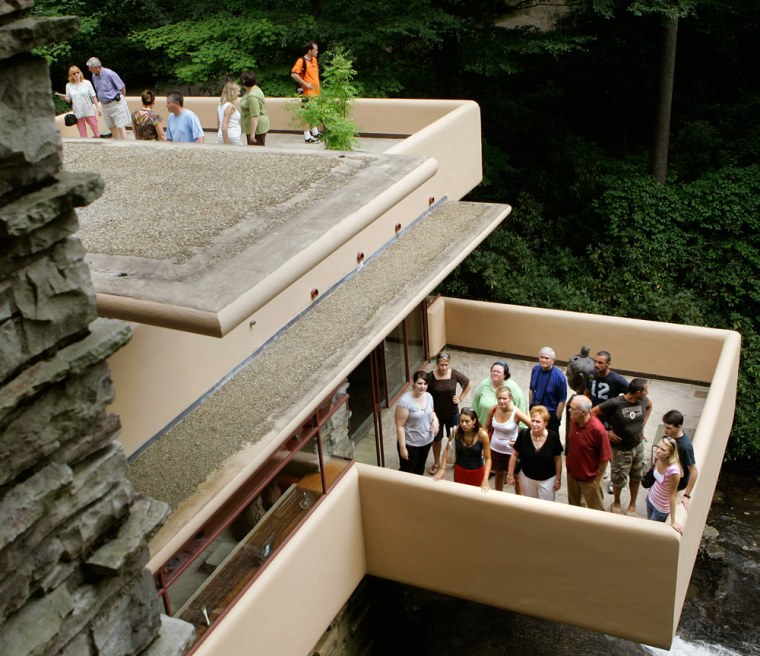Western Pennsylvania has long been home to two of renowned architect Frank Lloyd Wright's best known works, Kentuck Knob and Fallingwater.
Now, a third Wright creation, the Duncan House, has been moved here from Lisle, Ill., offering visitors a broad architectural experience — tours of two impressive homes and an overnight stay in a 1950s-era house.
Each of the homes is a different style, providing an overview of the artists' work in a 30-mile radius, making it one of just about a dozen places nationwide where several Wright buildings are on display in a concise area. Duncan House is one of only six Wright homes nationwide open to overnight guests.
"This is the trinity for us," said Patricia Coyle, director of marketing at Kentuck Knob. "We sell fantasy here because people come through here and they are transcended from their every day life into Frank Lloyd Wright's vision."
Fallingwater, designed for the Kaufmann family of the department store fortune, is an upscale home that cost $155,000 in 1937, or $2.1 million today. The house's concrete terraces flow over and alongside the Bear Run waterfall, giving the appearance that it is one with nature.
Currently maintained and run by the Western Pennsylvania Conservancy, Fallingwater gets more than 120,000 visitors annually. Last December, actress Angelina Jolie surprised boyfriend Brad Pitt with a visit to the home for his birthday.
At a time when Wright had become known as the "old man of modern architecture," Fallingwater broke a 10-year lull in his work, tour guide Louise Dean shouts over the roar of the nearby waterfall.
Fallingwater made Wright popular again, and he went on to design another 200 buildings, among those Kentuck Knob and Duncan House.
Located just seven miles from Fallingwater, Kentuck Knob was built in 1956 for the Hagans, who owned the largest dairy farm west of the Alleghenies. The home is considered a higher-end Usonian, a name coined by the architect for works aimed at the middle class.
The stone house with its copper roof has a hexagonal theme. The six-sided shape aligns the overhangs and fills the skylights as the house stands in grand style over the Youghiogheny River gorge.
Wright, who was working on 12 other projects at the time, including the Guggenheim Museum in New York, visited the property only once for three hours while it was being built. He designed the entire structure by looking at topographic maps and interviewing the Hagans.
The home opened to visitors 11 years ago, when Lord Peter Palumbo, the current owner, sought a way to maintain the house he bought for $600,000 in 1986. Palumbo, a friend of the late Princess Diana and Great Britain's royal family, put a massive sculpture garden on the property, including two pieces of the Berlin Wall.
Just 15 miles from there — but about a 30 minute drive along winding mountain roads — is the Duncan House. A more modest, prefabricated Usonian, it is one of only nine of this type ever built.
Carefully reconstructed on the 125-acre Polymath Park Resort, the home opened in June to overnight guests, nearly a year after the grueling process of putting it back together began.
"Every day was problem-solving really ... The challenge was not only rebuilding a house built 50 years earlier, but one that had fallen into disrepair," said Laura Nesmith, the resort's director, explaining that many parts had to be refurbished as construction was in process.
Since it opened, the house has been a raging success. Overnight stays are already booked straight through Thanksgiving.
"A lot of these people, their life dream is to see Fallingwater and they can't sit and they can't touch and then they come here and they can lay on the coach, and they love it," Nesmith said.
Spacious, bright and affordable at $47,000 — or about $350,000 today — Duncan House is a perfect example of Wright's attempt to allow the middle-class family to leave what he called "the box." Fifty years after it was originally built, the home remains modern.
The exterior is adorned with stripes in Cherokee red — Wright's signature color. The interior remains true to the year it was built, 1957: The kitchen has red Formica countertops, the appliances are original, the doors open accordian-style, the walls are bleached mahogany.
Yet the one-story design — featuring large windows, cathedral-style ceilings, a three-step drop to the living room, a carport door leading to the kitchen and master bedroom's glass shower stall — is evidence that today's ranch homes are direct descendants of Wright's Usonians.
"If you looked at all three of these houses you could see how Wright responded to a wealthy client, an upper middle-class client and a middle-class family," said Lynda Waggoner, director of Fallingwater. "It gives you a spectrum of his work."
